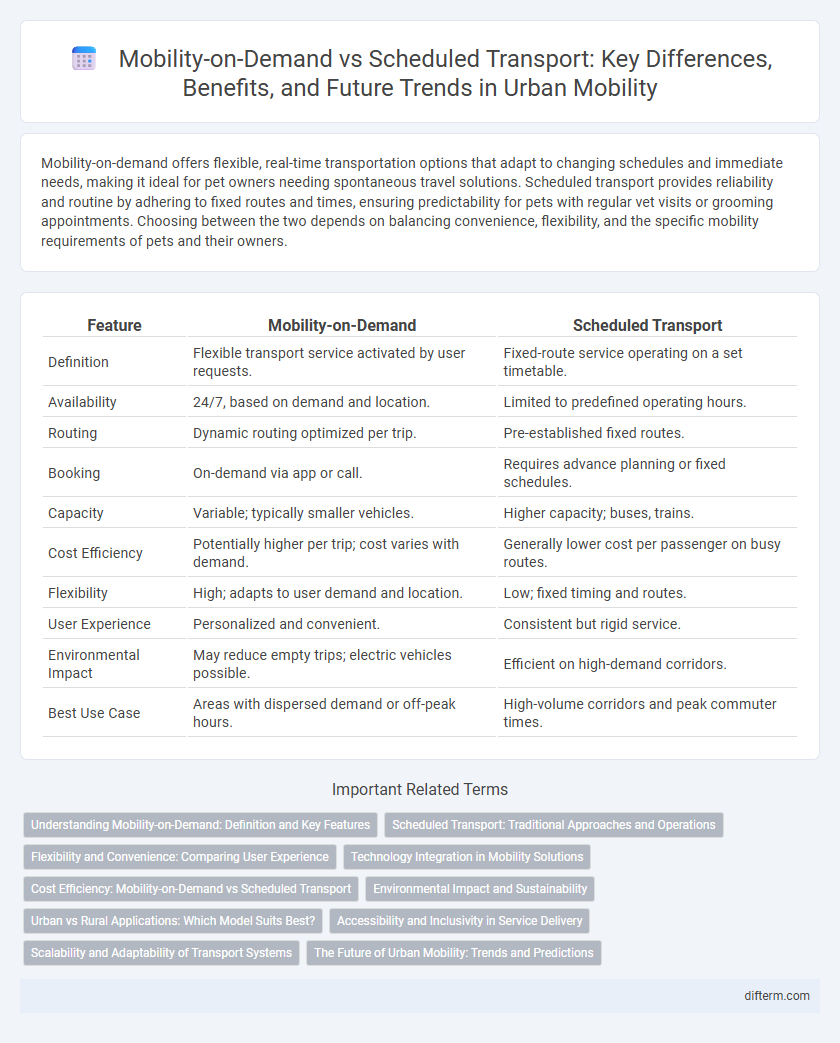Mobility-on-demand offers flexible, real-time transportation options that adapt to changing schedules and immediate needs, making it ideal for pet owners needing spontaneous travel solutions. Scheduled transport provides reliability and routine by adhering to fixed routes and times, ensuring predictability for pets with regular vet visits or grooming appointments. Choosing between the two depends on balancing convenience, flexibility, and the specific mobility requirements of pets and their owners.
Table of Comparison
| Feature | Mobility-on-Demand | Scheduled Transport |
|---|---|---|
| Definition | Flexible transport service activated by user requests. | Fixed-route service operating on a set timetable. |
| Availability | 24/7, based on demand and location. | Limited to predefined operating hours. |
| Routing | Dynamic routing optimized per trip. | Pre-established fixed routes. |
| Booking | On-demand via app or call. | Requires advance planning or fixed schedules. |
| Capacity | Variable; typically smaller vehicles. | Higher capacity; buses, trains. |
| Cost Efficiency | Potentially higher per trip; cost varies with demand. | Generally lower cost per passenger on busy routes. |
| Flexibility | High; adapts to user demand and location. | Low; fixed timing and routes. |
| User Experience | Personalized and convenient. | Consistent but rigid service. |
| Environmental Impact | May reduce empty trips; electric vehicles possible. | Efficient on high-demand corridors. |
| Best Use Case | Areas with dispersed demand or off-peak hours. | High-volume corridors and peak commuter times. |
Understanding Mobility-on-Demand: Definition and Key Features
Mobility-on-Demand (MoD) refers to flexible, real-time transportation services that allow users to request rides via digital platforms, offering personalized routes and schedules unlike traditional scheduled transport systems. Key features include dynamic routing, immediate availability, and integration with various transport modes, enhancing convenience and reducing wait times. MoD platforms leverage data analytics and GPS technology to optimize fleet management and improve urban mobility efficiency.
Scheduled Transport: Traditional Approaches and Operations
Scheduled transport relies on fixed routes and timetables, ensuring predictable and reliable service for commuters and travelers. These traditional approaches optimize vehicle utilization and streamline operations through centralized scheduling and consistent stop patterns. Coordination between transit agencies and infrastructure supports efficient passenger flow and reduces delays in urban mobility systems.
Flexibility and Convenience: Comparing User Experience
Mobility-on-demand offers superior flexibility and convenience compared to scheduled transport by allowing users to access rides instantly without adhering to fixed timetables, enhancing responsiveness to dynamic travel needs. This service model adapts to real-time demand and user location, minimizing wait times and route deviations, which improves overall user satisfaction. Scheduled transport, while reliable for routine commuting, lacks this personalized adaptability, often resulting in longer wait periods and less efficient journey planning.
Technology Integration in Mobility Solutions
Mobility-on-demand leverages real-time data analytics, GPS tracking, and mobile app integration to provide flexible, user-centric transport options that adapt dynamically to passenger needs. Scheduled transport relies on pre-set routes and fixed timetables, utilizing technology primarily for operational efficiency and schedule adherence. Advanced technologies such as AI-powered routing algorithms and IoT connectivity are increasingly bridging gaps between these models, enhancing overall mobility ecosystem responsiveness.
Cost Efficiency: Mobility-on-Demand vs Scheduled Transport
Mobility-on-demand (MOD) systems reduce operational costs by dynamically matching supply with real-time passenger demand, minimizing empty vehicle miles and optimizing fuel consumption. Scheduled transport incurs higher fixed expenses due to predetermined routes and timetables, often resulting in underutilized capacity during off-peak hours. Studies indicate MOD can cut operational costs by up to 30% compared to traditional scheduled transit, making it a cost-effective solution for urban mobility.
Environmental Impact and Sustainability
Mobility-on-demand services reduce vehicle emissions by optimizing route efficiency and minimizing empty runs, significantly lowering the carbon footprint compared to traditional scheduled transport. Scheduled transport, while potentially supporting high passenger volumes on fixed routes, often runs under capacity, leading to unnecessary fuel consumption and higher environmental impact. Integrating real-time mobility-on-demand with scheduled services can enhance sustainability by balancing demand responsiveness with resource efficiency.
Urban vs Rural Applications: Which Model Suits Best?
Mobility-on-demand (MOD) systems offer flexible, real-time transportation options ideal for urban areas with high population density and dynamic travel patterns, while scheduled transport remains more efficient for rural regions characterized by lower demand and longer travel distances. Urban centers benefit from MOD's ability to reduce wait times and optimize vehicle utilization through data-driven routing algorithms, enhancing commuter convenience and reducing congestion. Conversely, rural applications favor scheduled services due to predictable demand, cost-effectiveness, and established infrastructure supporting fixed routes.
Accessibility and Inclusivity in Service Delivery
Mobility-on-demand enhances accessibility by offering flexible, real-time transport options that adapt to individual needs, reducing barriers for people with disabilities and those in underserved areas. Scheduled transport provides predictable, fixed routes that ensure consistent service for communities but may lack responsiveness to varying accessibility requirements. Integrating both models supports inclusive service delivery by combining the reliability of scheduled systems with the personalized reach of on-demand mobility.
Scalability and Adaptability of Transport Systems
Mobility-on-demand systems offer superior scalability by dynamically adjusting vehicle deployment based on real-time demand, enhancing efficiency during peak and off-peak hours. Scheduled transport relies on fixed routes and timetables, limiting adaptability to fluctuating passenger needs and leading to underused capacity or overcrowding. Incorporating data-driven algorithms in mobility-on-demand enables responsive service changes, optimizing transport system performance across diverse urban environments.
The Future of Urban Mobility: Trends and Predictions
Mobility-on-demand services offer flexible, real-time transportation options driven by advanced algorithms and smartphone connectivity, contrasting traditional scheduled transport's fixed routes and timetables. Urban planners predict a shift towards integrated multimodal networks combining on-demand solutions with scheduled transit to optimize efficiency and reduce congestion. Emerging trends include AI-powered demand forecasting and seamless payment systems that enhance user experience and accessibility in evolving smart cities.
mobility-on-demand vs scheduled transport Infographic

 difterm.com
difterm.com